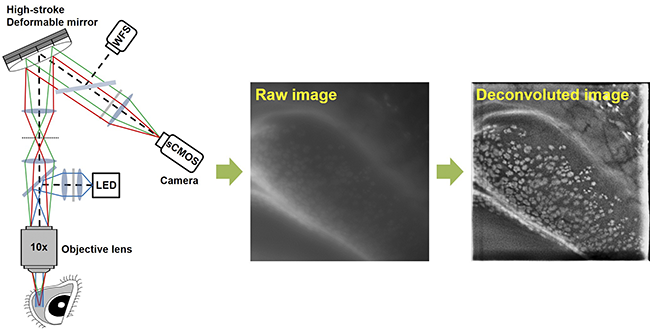Conjunctival Goblet Cells (CGCs) are specialized epithelial cells that secrete mucins to generate the tear film’s mucus layer. The mucus layer protects the ocular surface by spreading the tear film. Tear film instability is caused by CGC dysfunction and mortality, which is linked to a variety of ocular surface diseases, including dry eye disease (DED).
 Image acquisition and image processing using the mouse conjunctiva as an example. Image Credit: Pohang University of Science & Technology.
Image acquisition and image processing using the mouse conjunctiva as an example. Image Credit: Pohang University of Science & Technology.
Because DED is a multifactorial disease with various causes, it is critical to figure out what is causing it and how serious it is. As a result, CGC examination is critical for accurate diagnosis and successful treatment of ocular surface illnesses; yet, due to a lack of non-invasive equipment, CGC evaluation has not been possible until now.
Professor Ki Hean Kim and PhD candidates Jungbin Lee and Seonghan Kim (Department of Mechanical Engineering) of POSTECH developed a high-performance microscopy system for non-invasive CGC examination in patients in collaboration with professors Hong Kyun Kim and Byeong Jae Son (Department of Ophthalmology) of Kyungpook National University and Professor Chang Ho Yoon (Department of Ophthalmology) of Seoul National University.
This discovery was recently published in IEEE Transactions on Medical Imaging, an international publication on medical imaging, and was recognized for its technological development and promise.
The study team had previously identified for the first time that moxifloxacin, an FDA-approved ophthalmic antibiotic, stains CGCs and exhibited high-contrast CGC imaging employing moxifloxacin as a cell labeling agent earlier in 2019. However, because of several constraints of traditional microscopy methods like shallow depth-of-fields (DOFs) and poor imaging rates, CGC imaging in humans proved difficult.
The study team created a high-speed extended DOF microscope with a 1 mm DOF (25x DOF extension) and 10 frames per second imaging speed to overcome these restrictions. The device employed a deformable mirror to axially scan the image plane to collect CGCs in single frames on the arbitrarily tilted conjunctiva.
Deconvolution was used to filter only the in-focus information from the obtained photos, which comprised both in-focus and out-of-focus information. The researchers were able to show real-time, large-area CGC imaging in living mouse and rabbit models using the novel technology.
The newly developed imaging system can obtain high-resolution in-focus images of CGCs in live animal models and is also applicable to humans. Going forward, we will develop a device for imaging patients and then run clinical trials to test the feasibility of non-invasive CGC examination in the diagnosis and treatment of ocular surface diseases.”
Ki Hean Kim, Professor, Department of Mechanical Engineering, Pohang University of Science and Technology
Source:
Journal reference:
Lee, J., et al. (2022) Moxifloxacin-Based Extended Depth-of-Field Fluorescence Microscopy for Real-Time Conjunctival Goblet Cell Examination. IEEE Transactions on Medical Imaging. doi.org/10.1109/TMI.2022.3151944.